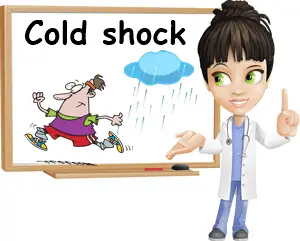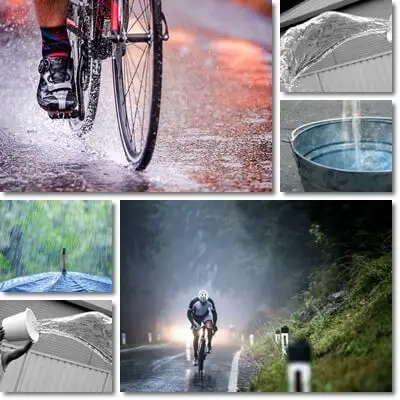It’s a beautiful day outside and you’re riding your bike, but then get caught in the rain. At first you feel hot, but then, as the heat starts leaving your body, you find yourself breathing heavily. Breaths becomes deep, long and rapid and you find yourself gasping for air and almost breathless. You feel your chest heavy, your extremities tingling and maybe even a bit dizzy and weak. Your body is in distress as the cold rain draws out the heat and you find yourself struggling to control your breathing and heart rate. Guess what: what you are experiencing is a cold shock and you’d better find shelter and get out of the rain.
What is cold shock?
By definition, cold shock is a state of severe physical and mental distress brought on by unexpected exposure to cold/particularly low temperatures – most commonly cold water. The shock is actually caused by the differences in temperature – body temperature vs low environmental temperatures the body is exposed to. What contributes to the shock is the suddenness of the exposure which leaves a person no time to prevent the event or prepare for the physiological impact.

An example of cold shock is cold water shock, which refers to the physiological effects brought on by exposing the body to sudden and significant amounts of cold water. For instance, swimming in cold/icy waters, swimming in winter or when it’s extremely cold outside, having cold water thrown at/on you (think of the famous ice bucket challenge) or getting caught in the rain and getting soaked, whether it’s hot or cold outside, can all trigger a cold shock response and associated symptoms.
What are the symptoms of cold shock?
1) Cold sensation, drop in body temperature beginning with the skin (in response to the cold, blood vessels start to constrict and the first to be affected are blood vessels in the skin).
2) Breathlessness, triggering of the gasp reflex which may cause a person to swallow water (presents with a drowning risk because water may be accidentally inhaled – also see water aspiration in lungs).
3) Chills, shivering that gets worse the longer the exposure to cold temperatures.
4) Shortness of breath due to the distress caused by the difference in temperature (body vs environment).
5) Hyperventilation: abnormally deep, long, rapid breaths.
6) Agitation, panic and a feeling of impending doom – especially if the water is too deep, too cold etc.
7) Fast heart rate, fast respiratory rate.
8) Further contraction of blood vessels which puts strain on the cardiovascular system to pump blood.
9) Chest pain, blurred vision, dizziness, fainting sensation, tingling sensation in extremities – caused by hyperventilation which increases oxygen levels in the blood whilst decreasing carbon dioxide levels.
10) Muscle spasms, cramps, weakness (low temperatures, effort to swim/stay afloat may contribute to the symptoms).
11) Muscle paralysis from the cold water (water temperatures usually have to be very low).
12) Heart attack – heart may stop as a result of the cold shock, even in healthy individuals.
Symptoms of cold shock occur almost instantly and get worse the longer the body is experiencing thermal distress. Some situations are worse than others, especially those involving water. For example, having cold water thrown at your face may only cause a short-lived set of mild symptoms in otherwise healthy people, including triggering of the gasp reflex followed by hyperventilation (abnormally deep and rapid breathing). Unless a person has respiratory, cardiac problems or other chronic conditions, they should be able to recover in a matter of minutes and their breathing return to normal without other side effects.

Whereas total immersion in cold water (whether voluntary – swimming in cold water, or accidental – falling through thin ice) causes more severe symptoms that escalate to potentially life-threatening situations, even for otherwise healthy individuals. On the one hand, the total immersion in cold water and the onset of cold shock symptoms are a source of significant distress for the body. This alone can prove life-threatening because it can potentially cause the heart to stop.
On the other hand, the symptoms (gasping for air, hyperventilation, muscle spasms, vasoconstriction) can make it difficult for a person to remove themselves from the situation. And the more time they spend in that situation, the more likely the risk of hypothermia.
What causes cold shock?
Situations likely to lead to such a physiological response include:
1) Throwing large amounts of cold water at someone (example: ice bucket challenge, water balloon games).
2) Total immersion in cold water: swimming, falling through ice, falling off a boat etc.
3) Taking a cold shower when temperatures are high and you’re hot.
4) Switching between cold water and hot water when showering.
5) Throwing cold water at yourself to cool off from exercising.
6) Getting caught in the rain – walking, jogging, biking, exercising when it’s hot outside, then getting caught in a storm and getting soaked.
The body is all hot from both high weather temperatures and exercising and this contributes to an even ampler thermal shock, especially for someone with existing respiratory or cardiovascular problems.
7) Getting soaked by a car speedily going over a puddle.
Cold water shock and asthma
If you have asthma, then cold water is something you definitely want to avoid. The condition itself makes you more vulnerable to the side effects of cold shock and can instantly trigger an asthma episode. Ideally, avoid games involving water (ice bucket challenge, throwing water balloons, playing with toys designed to spray or spurt water), cold or hot-cold showers, getting caught in the rain and immersing yourself in cold water (even swimming in the sea when it’s hot outside). The symptoms of cold shock, the breathlessness, hyperventilation and agitation are triggers for asthma. In some cases, even gulping down ice water or ice tea or other cold beverages can cause an asthma episode (due to the difference in temperature felt at the level of the esophagus and chest as the chilled beverages go down the esophagus).
Treatment for cold shock
Treatment options vary depending on the situation and severity of symptoms. The first step is to remove the triggers (example: get out of the water, out of wet clothes, out of the rain). Find shelter, a heat source and dry, warm clothing, depending on the case. Breathing needs to be controlled to prevent/stop hyperventilation (which can cause involuntary water aspiration into the lungs, asthma episodes and fainting). But most important, learn to prevent/avoid situations that might lead to cold shock. Don’t throw cold water at your or other people, don’t take cold showers, don’t go swimming in icy water, at night, in winter or at all if you have severe asthma and monitor the weather so you’re not caught unprepared in the rain. If you’re on a boat, follow safety measures (example: wear a life jacket, don’t lean over the edge and risk falling in the water).
